7 DIY Mess-Free Sensory Bags
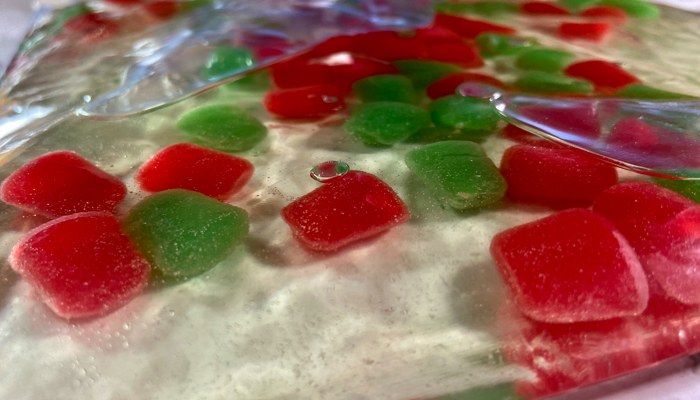
This post may contain affiliate links; please see our terms of use for details.
- Mess-free sensory bags are a fun way to introduce children to different textures without creating unnecessary clutter.
- Sensory bags, also called squish bags, can help develop social skills in children and help them explore different textures.
- The best sensory bag ideas explore the five senses and help kids with sensory input and processing.
My oldest son had sensory issues when he was a toddler, and I turned to the internet to help find ways to encourage sensory play. While there are many ideas, I found it essential to find crafts that piqued his interest.
Sensory bags are fun crafts that work on fine motor skills and provide playtime for babies and toddlers. Our list of sensory bag ideas will leave you feeling inspired and ready to put on your DIY hat.
What Are Sensory Bags?
You can fill sensory bags with everyday materials and supplies, usually found in your house. In addition, they are an inexpensive craft project that is easy to make and perfect for sensory play.
Babies put everything in their mouths, so making something chew-proof makes sense. Sensory bags provide sensory play, which helps stimulate your child’s senses.
While sensory bags are safe for young children, providing adult supervision is always a good idea to ensure they don’t open the bag.
Your baby can start using sensory bags when they are infants, which helps keep them entertained during tummy time. Since not all babies love tummy time, it offers a fun change of pace for little ones.
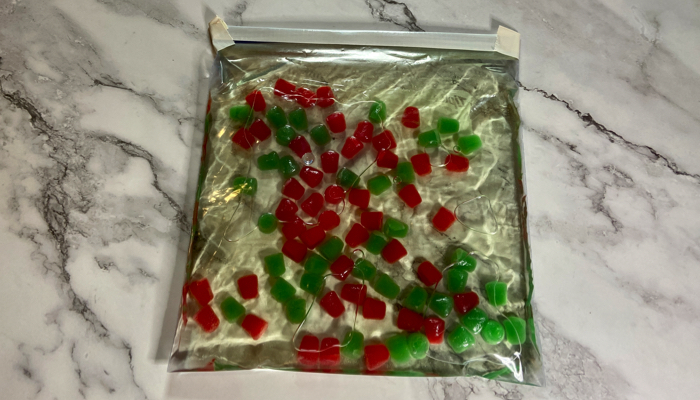
What Are Sensory Bags For?
Sensory bags provide sensory stimulation, specifically activating our senses of sight and touch. However, they also open the world and are a learning tool for discovering various textures.
In addition, sensory bags aren’t just a squishy craft (although they are fun!) with potentially messy side effects. Instead, they can help develop fine motor skills and language skills and are great at keeping children entertained.
Toddlers who play with sensory bags can help increase their vocabulary by describing what they feel and see. You’ll also notice your child developing sensory motor skills, allowing them to interact with their world.
Additional benefits of sensory bags include:
- They help develop sensory input, the information our brains get from our senses
- Aid in maintaining a child’s focus and attention
- Develop math and science skills
- Learning social life skills by working alongside other children
According to PeaceHealth, children with sensory processing disorder have difficulty processing information from their senses, leading to issues with responding appropriately.
However, providing your child with activities challenging their sensory input can help them respond correctly.
Things You Need to Make Sensory Bags
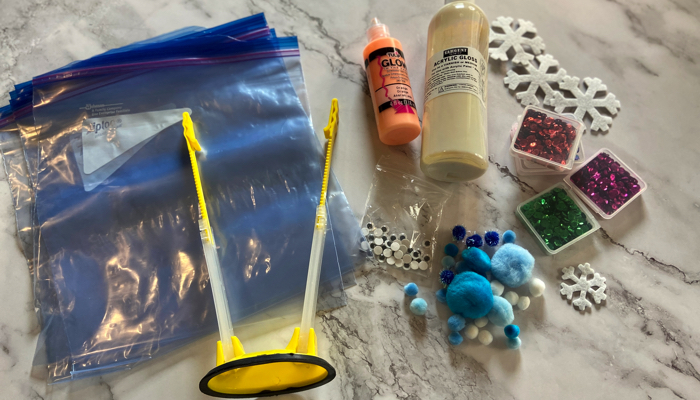
Before you start, here are a few materials you’ll need to make sensory bags. You don’t need everything from the list to create a sensory bag, but it gives you an idea of everyday items used:
- Gallon Ziplock bags
- Plastic bag holder
- Paints
- Glue
- Pom poms
- Googly eyes
- Shaving cream
- Vegetable oil
- Tape
- Hair gel
- Food coloring
- Baby oil
- Duct tape
As a side note, you can get most items at the dollar store, and the entire bag will likely cost you less than twenty dollars.
Guide on How to Make a Sensory Bag
If your toddler has significant muscles, you can double bag and use duct tape, ensuring nothing leaks. You, of course, will have to provide some adult supervision, but sensory bags can make for great independent play.
Here’s a quick overview of how to make a sensory bag:
- Fill a plastic bag with paint or hair gel
- Choose a theme and add desired objects
- Remove excess air and seal the bag
- Apply duct tape to the top for extra security
- Have fun!
The American Academy of Pediatrics reports how sensory play can help reduce stress in children and is an excellent alternative to television and other screen-related activities.
7 Fun and Easy-to-Make Sensory Bags
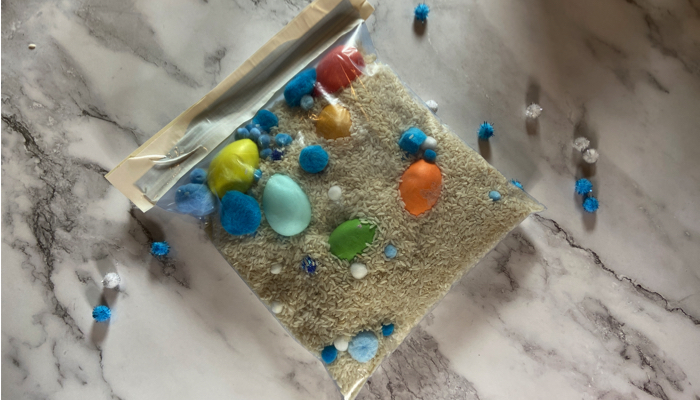
Holiday Themed Sensory Bag
Creating a holiday-themed sensory bag is the perfect way to ring in the season. Regardless of the holiday, you can make a sensory bag by finding objects representing the day.
For example, you can dye hair gel orange for Halloween and add pumpkins, ghosts, and skeletons in the Ziplock bag. Pumpkin seeds are also very fun to play with in a sensory bag!
Under-The-Sea
There are so many ideas for an under-the-sea theme you might find yourself making more than one sensory bag. I love the idea of a colorful bag filled with various sea creatures, especially since it doubles as a learning activity.
You can add water beads to your sensory bag, but ensure you seal them because they are dangerous to ingest.
Glittery Snowfall
I don’t love glitter (what parent does?), but adding it to a sensory bag adds a slight shimmer. Plus, it’s zipped up and likely won’t spill on your living room rug.
If it’s the cold of winter, you can keep the fun inside by creating a snowfall sensory bag. You can make this in several ways, including adding hair gel, glitter, and cut-out snowflakes.
Hair gel is typical in sensory bags because it is inexpensive, thick, and transparent.
Nature Sensory Bag
You can fill a nature sensory bag with all the fun things your kids bring in from outside, like leaves or acorns. I’d probably stay away from sticks because they likely will tear the bag, although toddlers won’t mind if that happens!
Your kids can also add flowers they find on the walk, adding color to the sensory bag.
Practicing Letters and Numbers
This easy sensory bag also helps your child practice writing their letters. I love this activity because it requires few materials and is one of my favorite kids’ activities.
First, put paint in the Ziplock bag, seal it, and tape it to the table to prevent it from moving around.
Next, your child can use their finger and write the letters in the paint. I recommend printing the letters and numbers so they have something to reference. Your child might need adult supervision to start, but it’s a great sensory activity they can do independently.
If you have a light table (and if you don’t, check out these DIY light table tutorials), these letter tracing bags work great with light shining through them!
Birdseed Sensory Bag
Filling up a plastic bag with birdseed is one of the most straightforward sensory bags you can assemble. Babies will enjoy pushing the seeds around, and you can also hide little toys or pictures in the birdseed for kids to find.
Since you don’t want babies or toddlers putting the birdseed in their mouths, ensure you securely seal the bag and add duct tape for extra security.
Googly Eye Sensory Bag
Another fun sensory bag is to fill a plastic bag with googly eyes and dyed hair gel. You can find various-sized googly eyes at the dollar store, and toddlers will enjoy pushing them around the bag.
You can also draw faces on poster board and put them in the bag, allowing your child to push the eyes where they belong onto the faces.
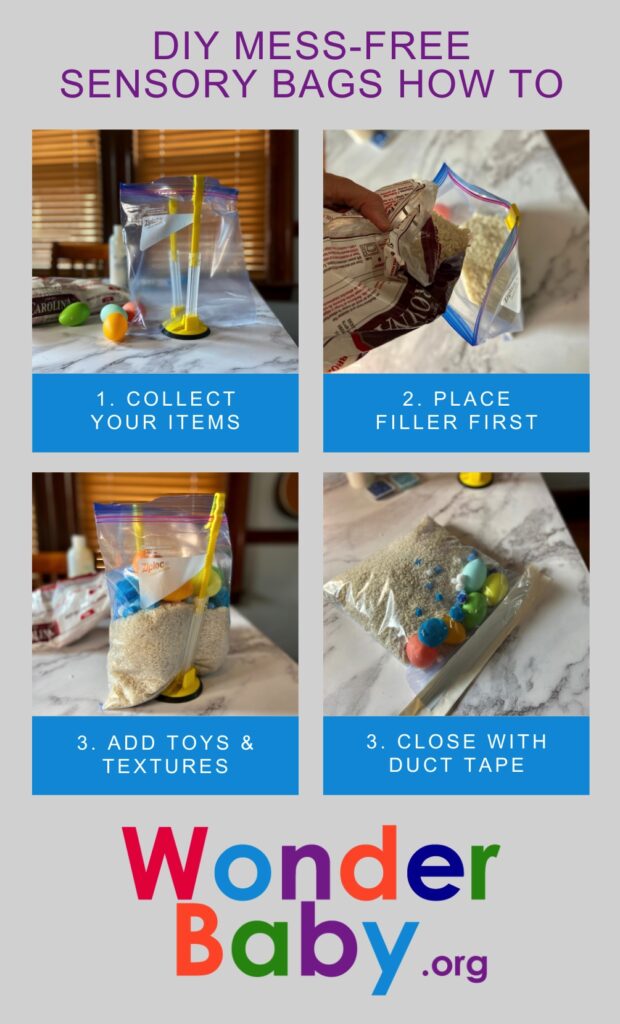
Related Posts

Braille and Literacy, Toys, Visual Impairment
24 Braille Toys for Kids Who are Blind
Everything from alphabet blocks to raised line coloring pages and activity books to puzzles to card and board games... and so much more! And it's all in braille ready for...

Holiday Crafts and Ideas
Should Parents Lie to Their Kids About Santa Claus?
Should parents lie about Santa? Find out how to balance trust, magic, and holiday traditions right here!

Holiday Crafts and Ideas, Special Needs
5 Tips for a Peaceful Thanksgiving with Your Child with Disabilities
Thanksgiving can be a joyful yet overwhelming holiday, especially for families with children who have sensory, motor, or dietary needs.